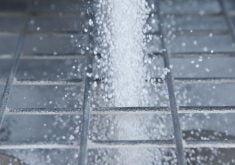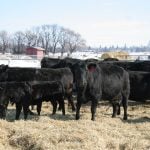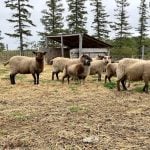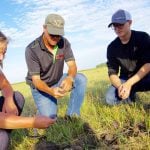Ted Harms and his team have been working with farmers for 13 years as they evaluate soil water sensors.
Harms, a provincial irrigation specialist in Alberta, said soil water sensors that are suitable for adoption by irrigators must be “fairly inexpensive (under $1,000), easy to use and interpret.”
He began his three-year project in 2000 by installing five kinds of sensors on farmers’ fields and comparing them for accuracy, stability and reliability of readings.
However, he said few farmers have continued using any of the sensors.
Read Also

Farmland ownership fires up Saskatchewan politicians
Saskatchewan politicians debate the enforcement of farmland ownership laws in the province.
“Some did buy and install them initially, but most found the effort wasn’t worth the information the instruments gleaned,” he said.
“Most of today’s market’s soil water sensors, for use by irrigation farmers, have as their output volumetric soil water content or a measure of soil tension (kPa or bars). Interpretation of that output to make a decision on when to and how much to irrigate is very much soil texture specific.”
Harms said farmers need a high level of analytical skill to understand these readings.
“For instance, if you have sandy loam soil and get a reading of 23 percent volumetric water content, you might not know where to go from there. With that kind of soil, that reading would mean that’s all the water that profile can hold. But if you get that same water content reading in clay soil, you’d better start irrigating,” he said.
There are easier ways to get the information. Many farmers will go with a manual step-on sampler called an Oakfield or a crank in Eijkelkamp auger,called a Dutch Auger.
“Then they feel the soil to see if it’s dry or wet to determine its water needs.”
There are three main methods to measure or estimate crop evapo-transpiration:
- A weighing lysimeter is a sensitive weighing mechanism. If the container is getting lighter, the weight loss is attributed to the water that the plants are transpiring.
- The Eddy flux covariant/correlation system measures turbulent fluxes such as wind speed and direction, incoming solar radiation, temperature and relative humidity.
- The Bowen ratio system, which Harms’ team uses, measures many of the same factors. The variables are then related by equations to how a crop is using water.
It’s mostly based on meteorological parameters, such as incoming solar radiation, temperature, relative humidity and wind speed.
CWB started promoting its Weather Bug Network in 2009. Producers would buy a weather station and soil probe. For a fee, CWB would advise them of the meteorological readings as well as their fields’ potential for evapo-transportation.
Harms said irrigation farmers are most interested in irrigation management products based on measured meteorological parameters.
“At last count, we had about 15 percent of irrigated acres in southern Alberta using them,” he said.
“We have an irrigation management model, which is a field-specific model that tracks your soil water, giving you a head’s up when you need to irrigate and how much water your soil profile is lacking.
“We also have a web-based one that tells you how a crop is using water on a daily basis: a chequebook method that tracks how much soil water has been used and how much precipitation has been received.”
The system uses local meteorological stations to measure short-wave solar radiation, temperature, RH, wind speeds and precipitation. No station is more than 30 kilometres from a field.
“The meteorological readings are related to how a crop is using water by calculating reference evapo-transpiration (alfalfa) using the Penman Montieth equation and relating that calculation to a specific crop using locally calibrated crop coefficient curves. The crop coefficient curve we use is unique for any crop,” he said.
“They all have their own curve for the particular way they mature, use water, and more. For high weed pressure situations, where weeds use more water that the system predicts, you just adjust it as needed. The same goes if there’s poor germination or hail.”
Weather Innovations offers similar services in Ontario, while Agriculture Canada provides it for fruit growers in British Columbia. Harms and his team make it available in Alberta, and it is also used in Saskatchewan and Manitoba.
Harms and his team just started working with variable rate irrigation from Nebraska manufacturers Valmont, T&L, and Reinky, which hire CropMetrics, an agronomic data services provider, to sell their technology.
“The technology was originally promoted to us as a way to avoid irrigating a particularly low spot,” said Harms.
“I was told they’d (CropMetrics) come up from Nebraska, do a map of the field, go back and send me a prescription for how to irrigate that particular field.
“What’s become apparent from that study is that we need a way to get information on what the pivot is doing and what we need it to do. We need soil water sensors in the field because we really need to know what’s going on with the soil water. It will have to be wireless and to be able to communicate on an almost hourly basis.”
This year, Harms is evaluating a wireless, soil water sensor network from Campbell Scientific, which will provide hourly soil water readings in specific areas of a field.
This will tell him if his soil water readings increased and how much irrigation water the pivot applied.
Producers may choose to adopt this for its energy and water saving attributes, which Harms said is seven to 20 percent, and for maximizing production per unit area.














